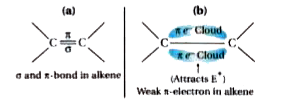Reactivity of alkene
Text Solution
In alkene, carbon-carbon has weak -bond.

Electrons of -bonds shows weak dynamic electrons. This type of -electrons source is present in alkene.
So such type of reactant and compounds attack on -bond and alkene and break -bond easily and forms compounds having single bond. So alkane compounds easily gives addition reaction.
-bond because alkene is more reactive and less stable than alkanes.
So, strength of C-C in alkane (bond ethalpy ), is less then strength of C-C in alkene (bond enthalpy 681 kJ/mol).
|
Topper's Solved these Questions
- HYDROCARBONSBOOK - KUMAR PRAKASHANCHAPTER - HYDROCARBONSEXERCISE - SECTION - A
55 Videos
- HYDROCARBONSBOOK - KUMAR PRAKASHANCHAPTER - HYDROCARBONSEXERCISE - Section - B objective questions (short questions)
147 Videos
- EQUILIBRIUMBOOK - KUMAR PRAKASHANCHAPTER - EQUILIBRIUMEXERCISE - Question Paper from Module
7 Videos
- HYDROGENBOOK - KUMAR PRAKASHANCHAPTER - HYDROGENEXERCISE - Section-D NCERT Exemplar (Long Answer)
8 Videos
Similar Questions
Knowledge Check

Which of the statements are correct about the reactivities of alkene, alkynes, and arenes?A(a) Ring (A) is more strained due to full double bond and is less stable than ring (B). Moreover, C atoms in ring (A) have more s character than those in ring (B), further making it less stable than ring (B). Hence, alkenes are more reactive towards EA reaction.B(b) EN of sp-hybridised C atom of alkynes is greater than sp2-hybridised C atom of alkenes, which holds the π electrons of alkynes more tightly. Moreover, there is a greater delocalisation of π electrons (due to cylindrical nature) in alkynes than in alkenes. In alkenes, π¯e's are less easily available for EA reactions than those in alkynes. So alkynes are less reactive than alkenes towards EA reactions.C(c) In alkynes, because of the cylindrical nature of their π-bonds, approach by hydrogen along the axis of cylinder is more effective. Thus the transition state in alkynes is less strained. So alkynes react faster than alkenes with H2.D(d) Arenes are more reactive towards EA reaction than alkenes and alkynes due to delocalisation of their π¯e's.In the elimination of reactions, that is, in the formation of alkenes, the reactivity of halogens in alkyl halides in the the order-
AI>Br>ClBCl>Br>ICBr>Cl>IDNoneWhat is the order of reactivity of these alkenes
(CH3)2C=CH2(I),CH3CH=CH2(II)andCH_(2)=CH_(2)(III) when subject to acid - catalysed hydration?AI>II>IIIBI gt III gt IICIII gt II gt IDII gt I gt III
Explain why alkynes are less reactive than alkenes toward addition of Br2.
View SolutionStatement-1: Alkynes are more reactive than alkene towards HBr
and Statement-2: Alkynes have higher degree of unsaturation than alkenes.
View SolutionWhat is the order of reactivity of these alkenes
(CH3)2C=CH2(I),CH3CH=CH2(II)andCH_(2)=CH_(2)(III) when subject to acid - catalysed hydration?
View SolutionS-I: Alkynes are more reactive than alkene towards catalytic hydrogenation
S-II: Alkynes are less reactive towards electrophilic reactio than alkenes
View SolutionA : Alkynes is more reactive than alkene towards electrophilic addition reaction.
R : Alkynes form stable carbocation than alkene.
View Solution
